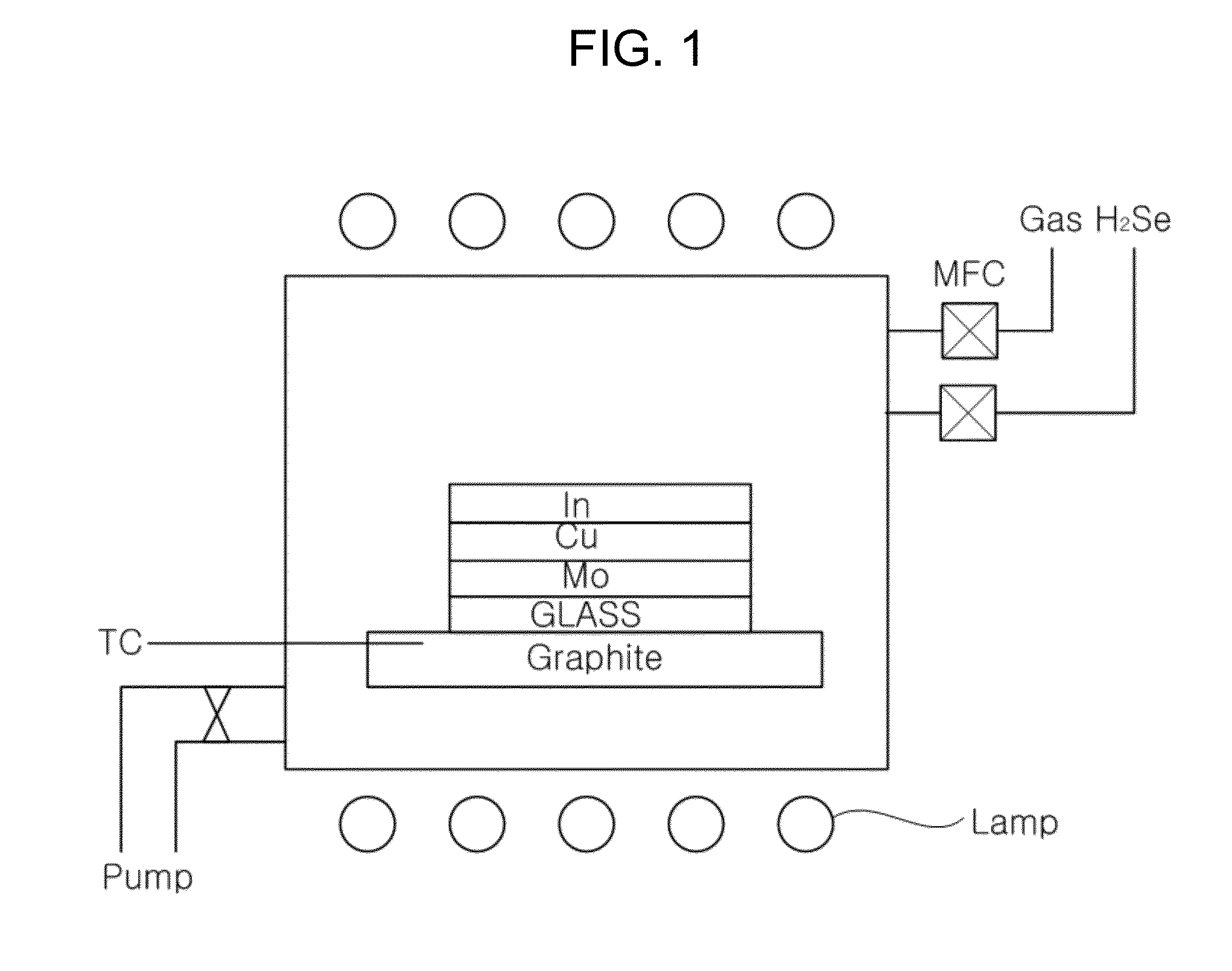Method of manufacturing light - absorbtion layer of solar cell through selenization process under elemental selenium vapor atmosphere and thermal processing apparatus for manufacturing light - absorbing layer
a technology of selenium vapor atmosphere and light absorbing layer, which is applied in the manufacture of final products, basic electric elements, coatings, etc., can solve the problems of low material utilization and high cost apparatus, difficulty in large-area deposition, and low throughput, and achieves high efficiency and reduces the production cost of the cigs light absorbing layer. , the effect of high efficiency
- Summary
- Abstract
- Description
- Claims
- Application Information
AI Technical Summary
Benefits of technology
Problems solved by technology
Method used
Image
Examples
first embodiment
[0050]FIG. 3 is a flowchart illustrating a sequence of processes of a method of manufacturing a light absorbing layer according to a first embodiment of the present invention. Referring to FIG. 3, the method is configured to include a step (Step 300) of controlling the temperature of all the wall of a sealed chamber to be a predefined thin film formation temperature, a step (Step 310) of loading a specimen where copper, indium, and gallium are laminated and selenium on a susceptor and inserting the susceptor into a chamber, and a step (S320) of heating the specimen by driving a heat source disposed under the susceptor and simultaneously heating element selenium by driving a heat source disposed above the susceptor. In Step 320, in order to allow the selenium not to be condensed on the specimen during the heating process, the temperature of the element selenium is controlled by using the heat source disposed above the susceptor so that the selenium vapor pressure in the vicinity of t...
second embodiment
[0083]Hereinafter, a sequence of processes of a method of forming the CIGS thin film on the substrate by using the manufacturing method according to the present invention will be described. The method of manufacturing the CIGS solar cell is configured to include a step of forming a back-side electrode layer on a soda lime glass (soda lime glass) substrate which is rinsed by RCA, a step of forming a light absorbing layer, a step of forming a buffer layer, a step of forming an I—ZnO layer, a step of forming a window layer, a step of forming an anti-reflection layer, and a step of forming a grid electrode layer and performing electrode wiring.
[0084]More specifically, in the method of manufacturing the CIGS solar cell, the substrate is formed with a thickness of 1 mm to 3 mm by using a soda lime glass. After the substrate is prepared, the substrate is rinsed through an RCA rinsing method by using deionized (DI) water. Besides the soda lime glass, a ceramic substrate such as alumina, a m...
third embodiment
[0090]In the method of the related art, there is a problem in that lower precipitation of gallium occurs during the selenization process, so that the efficiency is decreased. In order to solve the problem, one or two of sulfur(S) and a compound containing Na and the selenium are injected during the selenization process to sublimate Na functioning as a catalyst for forming high-quality CIGS, to prevent lower precipitation of gallium, and to improve the band gap. In this manner, during the selenization process, the selenium and one or two of sulfur(S) and a compound containing Na are injected, so that it is possible to generate a high-quality CIGS light absorbing layer.
[0091]While the present invention has been particularly shown and described with reference to exemplary embodiments thereof, it will be understood by those skilled in the art that various changes in form and details may be made therein without departing from the spirit and scope of the invention as defined by the append...
PUM
| Property | Measurement | Unit |
|---|---|---|
| Weight | aaaaa | aaaaa |
| Weight | aaaaa | aaaaa |
| Weight | aaaaa | aaaaa |
Abstract
Description
Claims
Application Information
 Login to View More
Login to View More - R&D
- Intellectual Property
- Life Sciences
- Materials
- Tech Scout
- Unparalleled Data Quality
- Higher Quality Content
- 60% Fewer Hallucinations
Browse by: Latest US Patents, China's latest patents, Technical Efficacy Thesaurus, Application Domain, Technology Topic, Popular Technical Reports.
© 2025 PatSnap. All rights reserved.Legal|Privacy policy|Modern Slavery Act Transparency Statement|Sitemap|About US| Contact US: help@patsnap.com



